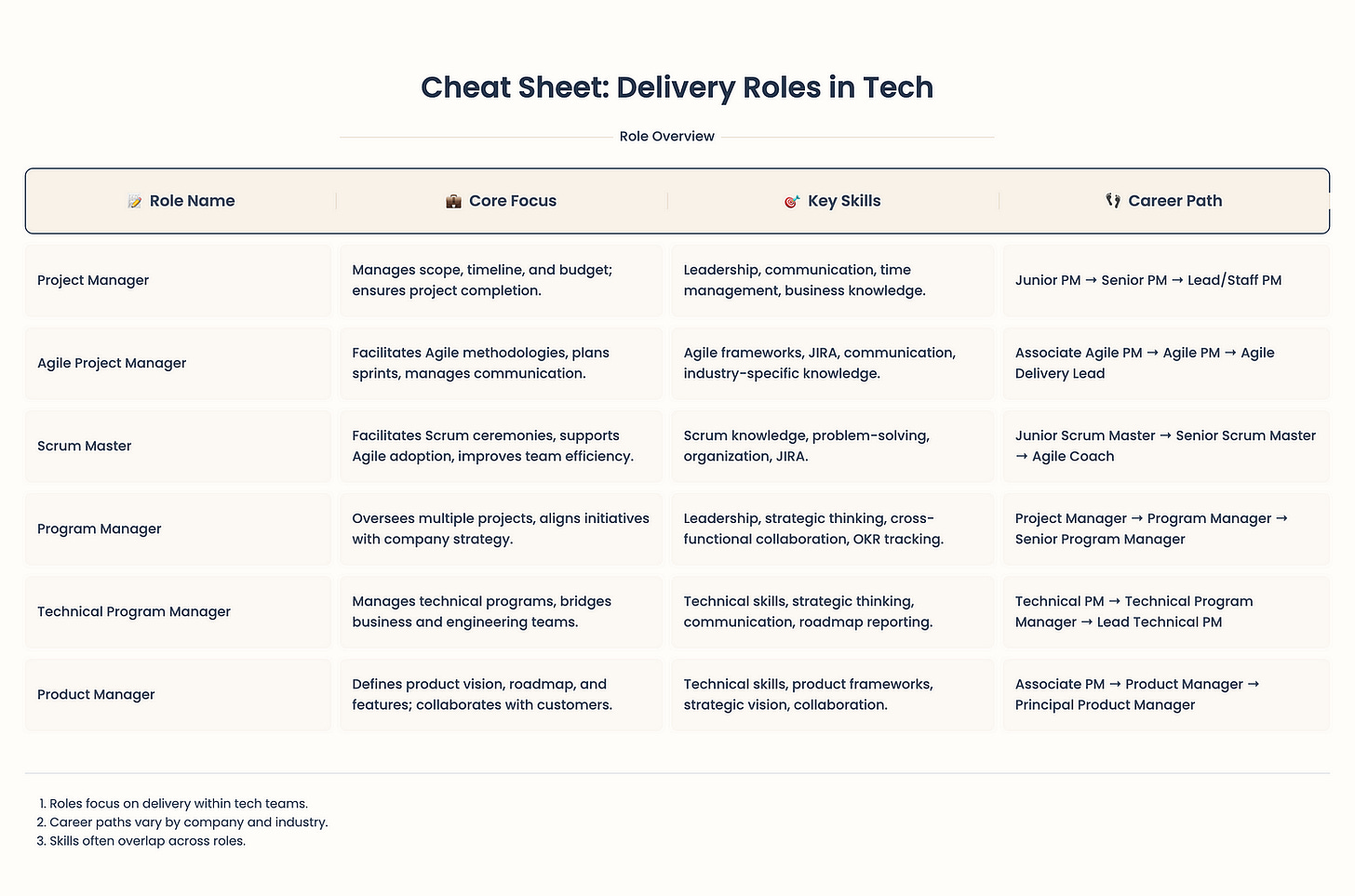6 Shades of Delivery Roles in Tech
On Project Management and its shades of grey in the software world

Note -1: All opinions are my own and reflect my experience. Roles vary by company, industry, and methodology, so if you’re applying for these roles, always do your company-specific research. You will notice some overlap across these which reflects the gray area and related nature of these roles in the Delivery world.
Note -2: I’ve skipped customer-facing roles in tech (e.g. Professional Services Project Manager, Delivery Lead), and focused on internal teams. The Product Manager section is also intended for the same approach — e.g. assuming a Product Manager working on internal tools, which is the role I have interacted with the most in my career so far.
Introduction: Tech delivery landscape
The usual “What do you do?” question comes up when conversing with people. I usually reply with the very vague “Oh, I work as a project manager” and, start waffling about my journey in the tech industry.
This piece intends to showcase there are more shades of roles under the general “project management” topic, and these shades have become more and more popular over the years. I aim to go over six key roles, their key features, and potential career paths, as well as how they differ from each other as well as the different skill sets they lean on.
The hope is to help you figure out whether any of these Delivery roles can be right for you, whether you’re in tech, looking to break into tech from another industry, or maybe even making a lateral role change into one of these.
Let’s dive in.
What does “Delivery” even mean?
Some context first. By Delivery roles, I mean roles that are centered on the act of (you guessed it) delivering a project, service, or product to an intended customer.
The customer can be external (think of a software company delivering an implementation project via a professional service project) or internal (think of an Operations department working on and delivering a project for the Accounting department).
By extension, I think of the consulting industry as a pure delivery industry, where the entire purpose and objective of the company is to continuously deliver projects for its customers. So delivery roles exist across industries, though this article specifically focuses on the nature of the roles as typically seen or interpreted within the Tech world.
I have experience working in delivery roles across the two industries, and highlight the major differences in another piece.
With context set, let’s look at the roles.
Project Manager
Role description 📝
The classic delivery role in the most industry-agnostic sense of the term, the Project Manager has become popular in the tech industry as well, especially in non-engineering departments (think of Marketing, Sales) that still need to rely on the role to ensure proper rollout of key department initiatives.
In a nutshell, the Project Manager manages the key pillars of a project ( scope, timeline, and budget) and works with the project team to bring the initiative to closure according to specifications.
Therefore the role manages projects end to end and has functional authority over all project activities.
Core Focus 💼
Engaging key project stakeholders
Managing the project schedule and key artifacts (documentation, project plan, change log, risk and assumptions register, etc)
Works closely with the project team to ensure progress and remove blockers
Manages key project communication and reports
Key Skills 🎯
Leadership skills
Presentation & Communication skills
Time management and organization skills at large
Business skills (many have a business background by academic degree)
Industry/company or department-specific business knowledge (e.g., knowledge of Sales Operations best practices in B2B SaaS companies)
Career Path Outline in Tech👣
Entry level (0–2 years): Junior Project Manager/Project Manager
Mid-level (2–7 years): Senior Project Manager
Senior Level (7+ years): promotion to management of a team of Project Managers or further specialization to Lead and/or Staff-level Project Manager
Agile Project Manager
Role description 📝
This variation of the Project Manager role is encountered in Agile environments, focusing on an iterative approach to project management centered on continuous improvement, continuous release of the project’s sub-components into smaller time-bound windows (Sprints), and focusing on managing the communication and collaboration of the team and customers within the Agile framework, which contrasts with more traditional project management approaches.
In a nutshell, the Agile Project Manager is a Project Manager working within an Agile Framework and development environment.
Core Focus 💼
Facilitating and ensuring adherence to Agile Methodologies
Helping the team with estimating & planning work that goes into Agile Sprints
Manages key project communication and reports
Manages the work backlog (this responsibility can be split/coordinated with the Product Manager depending on the ways of working at the firm)
Key Skills 🎯
Knowledge of Agile Frameworks and work estimating
Agile software (e.g. JIRA) for tracking work
Presentation & Communication skills
Industry/company or department-specific business knowledge (e.g., knowledge of Sales Operations best practices in B2B SaaS companies)
Career Path Outline 👣
Entry level (0–2 years): Associate Agile Project Manager / Agile Coordinator
Mid-level (2–7 years): Agile Project Manager
Senior Level (8+ years): Senior Agile Project Manager / Agile Delivery Lead
Scrum Master
Role description 📝
The Scrum Master is a role, or I should say more of a “hat” really, as their responsibilities are often covered by other delivery roles mentioned here.
In a nutshell, Scrum masters facilitate the adoption and adherence to the Scrum framework, a specific agile project management framework that “ helps teams structure and manage their work through a set of values, principles, and practices.” (Source: Atlassian)
It’s a role that’s often seen in Agile organizations with a key focus on:
Core Focus 💼
Facilitating Scrum Ceremonies
Supporting the adoption and collaboration of teams according to Agile Principles
Participate in agile meetings and help the team improve in multiple areas (collaboration, ways of working)
Ensuring overall team performance and efficiency
Key Skills 🎯
Deep knowledge of the Scrum Framework and Agile Principles
Communication and problem-solving
Organizational skills and time management
Agile software (e.g. JIRA) for tracking work
Career Path Outline 👣
Entry level (0–2 years): Junior Scrum Master/ Scrum Master
Mid-level (2–7 years): Senior Scrum Master
Senior Level (7+ years): Lead Scrum Master/ Agile Coach
Program Manager
Role description 📝
Where projects are managed by Project Managers, programs are collections of projects tied together along a common theme and are managed by Program Managers.
Therefore, Program Managers are to Programs what Project Managers are to Projects. Differently from Project Managers, Program managers operate at an even more strategic level vs. Project Managers, as they oversee a set of key programs often set at the company-wide level.
Therefore they often engage with Senior company executives, participate in key strategic meetings, and oversee the initiation, planning, and execution of multiple programs, often concurrently.
Therefore, they need the ability to operate at a 10,000-foot view of the company as much as they need to be operationally savvy to understand where projects within their programs stand at ground level and effectively collaborate with cross-functional stakeholders to ensure programs are delivered.
Core Focus 💼
Facilitating strategic alignment on key company initiatives
Cross-functional collaboration to ensure programs are resourced, supported, sponsored, and executed as needed
Presenting strategic initiatives to leadership
Effectively communicating on program status at Steering Committee meetings.
Crafting detailed memos and program-level communication to facilitate strategic decision-making
Key Skills 🎯
Leadership skills
Presentation & Communication skills
Strategic Thinking and cross-functional collaboration
Objectives and OKR tracking
Program Roadmap level reporting skills
Career Path Outline 👣
Entry level (0–2 years): Project Manager
Mid-level (2–7 years): Program Manager
Senior Level (7+ years): Senior Program Manager
Technical Program Manager
Role description 📝
The Technical Program manager emphasizes the “T” in Program Manager, which is managing technically-enabled programs that require software and/or product engineering work.
The strategic lens of these programs remains and is complemented by a technical layer. Oftentimes, Program Managers would partner up with Technical Program Managers to ensure that on sizable programs, both the business and technical components are given appropriate attention.
Spoiler: I’m currently working as a Technical Program Manager
Core Focus 💼
Cross-functional collaboration to ensure technical programs are resourced, supported, sponsored, and executed as needed
Collaborating with Program Managers and business stakeholders to bridge the gap between business objectives and technical program delivery
Crafting technical program memos and collaborating with engineering teams on requirements and functional design documents
Managing design, development, testing (QA+UAT), and release phases on key technical programs
Key Skills 🎯
Technical/analytics skills in the specific application domain
Presentation & Communication skills
Strategic Thinking and cross-functional collaboration
Objectives and OKR tracking
Program Roadmap level reporting skills
Career Path Outline 👣
Entry level (0–2 years): Technical Project Manager
Mid-level (2–7 years): Technical Program Manager
Senior Level (7+ years): Senior/Lead Technical Program Manager
Product Manager
Role description 📝
The Product Manager is indeed delivery-focused, with the key difference of working on a specific software product, defining its vision, feature roadmap, and customer use cases, and being the voice of the customer when taking product feedback.
At the same time, the Product Manager is expected to know the technical ins and outs of the software product they manage and relay customer interactions back to the internal engineering teams. For this reason, a PM in many cases has a technical background in the specific product area they cover.
Core Focus 💼
Defines and manages the vision and roadmap behind the product
Acts as the main point of contact for customers
Collaborates with customers to change adapt and prioritize product features
Works with engineering teams to handle product delivery according to the roadmap
Key Skills 🎯
Technical/analytics skills in the specific application domain
Product Management frameworks and/or hands-on experience (e.g. startup founder)
Strategic vision and leadership skills
Presentation and collaboration skills
Agile software (e.g. JIRA) for tracking the product roadmap
Career Path Outline 👣
Entry level (0–2 years): Associate Product Manager / Junior Product Manager
Mid-level (2–7 years): Product Manager / Senior Product Manager
Senior Level (7+ years): Senior Product Manager / Principal Product Manager
Summary
Here below, I summarized the key features for each role we’ve gone through thanks to MyLens.ai.
Here below, I summarized the key features for each role we’ve gone through thanks to MyLens.ai.
Overall, I hope this article gives you a useful overview of delivery roles in tech and helps you make sense of choosing one you may feel more aligned with as a potential next step in your career. Do reach out if you have questions on any of these!
Best of luck, enjoy the ride, and thanks for reading!
Disclosure: This article contains affiliate links. If you purchase through these links, I may earn a commission at no additional cost to you. I only recommend products and services I believe in and think will provide value to you.





